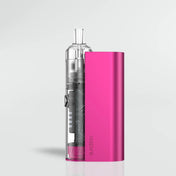Throughout the 20th century individuals and companies have been interested in the development of an aerosol based alternative to cigarettes. Despite this, it wasn’t until 2004 that the electronic cigarette system now known throughout the world was developed in China by Hon Lik, who wanted to create a device that would help him to quit smoking.
The Earliest Vape Device Designs
In 1963, a patent was granted in the U.S.A to Herbert A. Gilbert for a ‘smokeless, non-tobacco cigarette.’ Gilbert’s device used a battery to heat a liquid and produce a nicotine-free flavoured steam. Some of the flavours Gilbert suggested for his device were mint, cinnamon and rum. While this device is similar to contemporary e-cigarettes, it was never produced commercially. The two main reasons for this were the lack of social demand and the large, low-powered and expensive batteries at the time.
Even earlier, in 1927, an American called Joseph Robinson filed a patent for a device he called a 'Mechanical Butane Ignition Vaporizer'. His patent was approved three years later after some refinement but Robinson never brought it to the market. The concept was left under wraps for a few decades as a result until Herbert Gilbert developed his own, more advanced design.
'The Father of Vaping' - How China Started the Modern Vaping Revolution
In 2003 a patent was filed in China by Hon Lik for the e-cigarette system that is used throughout the world today. Lik was a heavy smoker and, following the death of his father from lung cancer, he wanted to create a device that would help him quit smoking. He has said, “I believed that if I could use vapor to simulate cigarette smoke, this could help me.”
Lik initially developed a large desktop system and experimented with food additives as solvents. He settled on Propylene Glycerol as a reliable, non-toxic solvent for nicotine that produced a satisfying vapour. Unlike Gilbert, Lik could use powerful and conveniently sized lithium ion batteries to turn his larger system into a more practical device.
Lik’s first vaping device featured an ultrasonic emitter that used high frequency vibrations to turn a jet of pressurised liquid into fine droplets. However, this was quickly changed to an atomiser with a heated coil, which produced larger amounts of vapour, with smaller droplets, while also heating it. It was this design, the Ruyaan Dragon, that would define the first steps of the global vaping phenomenon, and earn him the moniker 'The Father of Vaping'.
This was the system used in the first commercial electronic cigarette, released in China in 2004. It’s a simple system of vaporizing a liquid with a heated coil and it has become popular throughout the world in the years since. It has also continued to be modified, improved and developed upon by Lik himself, hobbyists everywhere and numerous companies, including us here at EDGE.
Our Sources:
https://www.smithsonianmag.com/innovation/plans-for-first-e-cigarette-went-up-in-smoke-50-years-ago-180970730/
https://www.reuters.com/article/us-ecigarettes-inventor-idUSKBN0OP1YV20150609
https://www.vapingpost.com/who-invented-the-vape/



